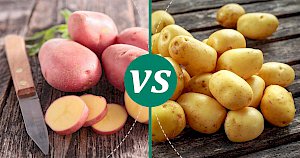Baby Potatoes vs Red Potato: Nutrition, Calories & Protein Compared


Baby potatoes vs Red potato
Nutrition Facts
Serving size:
change
5g10g15g20g30g40g50g60g80g100g120g140g160g180g200g220g250g300g350g400g450g500g600g700g800g900g1000g
1oz2oz3oz4oz5oz6oz7oz8oz10oz12oz15oz20oz25oz30oz35oz40oz50oz
Amount Per Serving:
Serving size:
change
5g10g15g20g30g40g50g60g80g100g120g140g160g180g200g220g250g300g350g400g450g500g600g700g800g900g1000g
1oz2oz3oz4oz5oz6oz7oz8oz10oz12oz15oz20oz25oz30oz35oz40oz50oz
Amount Per Serving:
Baby Potatoes vs Red Potato 100g Compare
| per 100g | Baby potatoes | Red potato |
|---|---|---|
| Calories | 82 | 70 |
| Carbohydrates | 17.27 g | 15.9 g |
| Dietary fiber | 0.9 g | 1.7 g |
| Protein | 2.73 g | 1.89 g |
| Iron | 0.98 mg | 0.73 mg |
| Sodium | 5 mg | 18 mg |
| Vitaminium C | 21.8 mg | 8.6 mg |
Discover the Delights of Baby Potatoes and Red Potatoes
When it comes to the world of potatoes, there's a vast variety to explore beyond the common russet. Two types that often catch the eye in the grocery aisle are the charming baby potatoes and the vibrant red potatoes. Both of these potato varieties bring unique flavors and textures to the table, making them favorites among home cooks and chefs alike. Before diving into the comparison, let's sprinkle some interesting facts about these tuber treasures.
Spotlight on Baby Potatoes
Baby potatoes, often referred to as new potatoes, are harvested earlier than their full-grown counterparts. This early harvest means they are smaller in size, have a tender texture, and a sweeter taste due to their higher sugar content. Baby potatoes come in a variety of colors, including yellow, red, and even purple, each adding a pop of color and a nutrient boost to dishes.
The Allure of Red Potatoes
Red potatoes, with their waxy texture and creamy taste, stand out with their ruby-red skin. The skin is not just for show; it's packed with antioxidants. Red potatoes are often medium-sized and hold their shape well after cooking, making them a perfect choice for salads, roasting, and boiling. Their slightly sweet flavor complements a wide range of dishes, from rustic stews to elegant side dishes.
Comparing the Culinary Champions
When deciding between baby potatoes and red potatoes, consider both nutrition and culinary use. Nutritionally, both varieties offer benefits such as being low in calories and fats, and high in vitamins and minerals. Baby potatoes boast a slightly higher calorie count at 82 calories per 100 grams compared to red potatoes at 70 calories, but this difference is minimal in the grand scheme of a balanced diet. The fiber content in red potatoes is almost double that of baby potatoes, making them a better choice for those looking to increase their dietary fiber intake.
Both varieties are fat-free and cholesterol-free, aligning with healthy eating guidelines. Red potatoes have a slight edge in terms of vitamin and mineral content, offering more vitamin C, potassium, and magnesium, which are essential for overall health. However, baby potatoes are not to be underestimated, as they provide a good source of vitamin C and iron.
Culinary Considerations
From a culinary perspective, the choice between baby potatoes and red potatoes often comes down to the desired dish outcome. Baby potatoes are best enjoyed when roasted whole or halved, showcasing their tender texture and natural sweetness. Their small size and quick cooking time make them a convenient option for busy weeknights.
On the other hand, red potatoes' firm texture makes them versatile for a variety of cooking methods, including boiling, mashing, and slicing into salads. Their ability to maintain their shape and texture after cooking is especially valued in dishes where presentation is key.
Final Thoughts
In the end, whether you choose baby potatoes or red potatoes, you're in for a treat. Both varieties offer distinct tastes and textures that can enhance any meal. Consider what you're cooking and the flavor profile you're aiming for when making your selection. And remember, the best way to discover your preference is to experiment with both in your kitchen. Happy cooking!
Baby potatoes 100g
82kcalCalories source
- 86% CARBS.
- 14% PROTEIN
- 0% FAT
Red potato 100g
70kcalCalories source
- 88% CARBS
- 10% PROTEIN
- 2% FAT
Compares of baby potato
- Baby Potatoes vs Potato
- Baby Potatoes vs Sweet Potato
- Baby Potatoes vs Russet Potato
- Baby Potatoes vs Red Potato
- see all compares of baby potatoes
Marcin Piotrowicz
calories-info.com creator
Healthy diet and healthy lifestyle promoter
Add comment